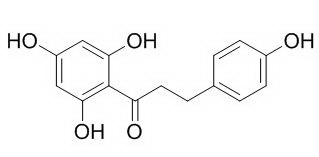Phloretin
Phloretin may potentially be an immunomodulator by impairing the activation and function of DCs, it is effective in preventing estrogen deficiency-induced osteoclastogenic resorption. Phloretin has antimicrobial activity against the Gram negative bacteria Salmonella typhimurium ATCC 13311. It has a wide spectrum of targets including ASK-1-MAPK, Smac, capase.
Inquire / Order:
manager@chemfaces.com
Technical Inquiries:
service@chemfaces.com
Tel:
+86-27-84237783
Fax:
+86-27-84254680
Address:
1 Building, No. 83, CheCheng Rd., Wuhan Economic and Technological Development Zone, Wuhan, Hubei 430056, PRC
Providing storage is as stated on the product vial and the vial is kept tightly sealed, the product can be stored for up to
24 months(2-8C).
Wherever possible, you should prepare and use solutions on the same day. However, if you need to make up stock solutions in advance, we recommend that you store the solution as aliquots in tightly sealed vials at -20C. Generally, these will be useable for up to two weeks. Before use, and prior to opening the vial we recommend that you allow your product to equilibrate to room temperature for at least 1 hour.
Need more advice on solubility, usage and handling? Please email to: service@chemfaces.com
The packaging of the product may have turned upside down during transportation, resulting in the natural compounds adhering to the neck or cap of the vial. take the vial out of its packaging and gently shake to let the compounds fall to the bottom of the vial. for liquid products, centrifuge at 200-500 RPM to gather the liquid at the bottom of the vial. try to avoid loss or contamination during handling.
Anticancer Res.2024, 44(3):1033-1044.
Mol Immunol. 2016, 78:121-132
Plants (Basel).2021, 10(6):1119.
Processes2021, 9(5),831.
Plants (Basel).2022, 11(16):2126.
Biosci Rep.2020, 40(8):BSR20201219.
Biol. Life Sci. Forum2024, 35(1), 6.
Plant Growth Regulation2020, 90(2):383-392
J Chromatogr B Analyt Technol Biomed Life Sci.2022, 1203:123307.
Microchemical Journal2023, 194:109249
Related and Featured Products
Food Chem. 2014 Oct 1;160:292-7.
Biochemical and antimicrobial activity of phloretin and its glycosilated derivatives present in apple and kumquat.[Pubmed:
24799241]
Phloretin and its glycosylated derivatives (phlorizin and Phloretin 3',5'-di-C-glucoside) are dihydrochalcones that have many interesting biological properties.
METHODS AND RESULTS:
The results obtained showed that the dihydrochalcones are able to inhibit growth of Gram positive bacteria, in particular Staphylococcus aureus ATCC 6538, Listeria monocytogenes ATCC 13932 and methicillin-resistant S. aureus clinical strains. Moreover, Phloretin is active also against the Gram negative bacteria Salmonella typhimurium ATCC 13311.
CONCLUSIONS:
The determination of the enzymatic activity of key metabolic enzymes allowed us to shed some light on the biochemical mechanism of aglycon cell growth inhibition, showing as it remarkably influences the energetic metabolism of S. aureus. In addition, structure/activity determinations highlighted that the presence of a glycosyl moiety bound to the chalcone structure dramatically decreases the antimicrobial activity of Phloretin.
Phytomedicine. 2014 Sep 15;21(10):1208-15.
Phloretin promotes osteoclast apoptosis in murine macrophages and inhibits estrogen deficiency-induced osteoporosis in mice. [Pubmed:
24932975]
Bone-remodeling imbalance induced by increased osteoclast formation and bone resorption is known to cause skeletal diseases such as osteoporosis. The reduction of estrogen levels at menopause is one of the strongest risk factors developing postmenopausal osteoporosis.
METHODS AND RESULTS:
This study investigated osteoprotective effects of the dihydrochalcone Phloretin found in apple tree leaves on bone loss in ovariectomized (OVX) C57BL/6 female mice as a model for postmenopausal osteoporosis. OVX demoted bone mineral density (BMD) of mouse femurs, reduced serum 17β-estradiol level and enhanced serum receptor activator of NF-κB ligand (RANKL)/osteoprotegerin ratio with uterine atrophy. Oral administration of 10 mg/kg Phloretin to OVX mice for 8 weeks improved such effects, compared to sham-operated mice. Phloretin attenuated TRAP activity and cellular expression of β3 integrin and carbonic anhydrase II augmented in femoral bone tissues of OVX mice. This study further examined that osteogenic activity of Phloretin in RANKL-differentiated Raw 264.7 macrophages into mature osteoclasts. Phloretin at 1-20 μM stimulated Smac expression and capase-3 activation concurrently with nuclear fragmentation of multi-nucleated osteoclasts, indicating that this compound promoted osteoclast apoptosis. Consistently, Phloretin enhanced bcl-2 induction but diminished bax expression. Furthermore, Phloretin activated ASK-1-diverged JNK and p38 MAPK signaling pathways in mature osteoclasts, whereas it dose-dependently inhibited the RANKL-stimulated activation of ERK.
CONCLUSIONS:
Therefore, Phloretin manipulated ASK-1-MAPK signal transduction leading to transcription of apoptotic genes. Phloretin was effective in preventing estrogen deficiency-induced osteoclastogenic resorption.
Food Funct. 2014 May;5(5):997-1006.
Immunomodulation of phloretin by impairing dendritic cell activation and function.[Pubmed:
24651121]
Dietary compounds in fruits and vegetables have been shown to exert many biological activities. In addition to antioxidant effects, a number of flavonoids are able to modulate inflammatory responses.
METHODS AND RESULTS:
Here, we demonstrated that Phloretin (PT), a natural dihydrochalcone found in many fruits, suppressed the activation and function of mouse dendritic cells (DCs). Phloretin disturbed the multiple intracellular signaling pathways in DCs induced by the Toll-like receptor 4 (TLR4) agonist lipopolysaccharide (LPS), including ROS, MAPKs (ERK, JNK, p38 MAPK), and NF-κB, and thereby reducing the production of inflammatory cytokines and chemokines. Phloretin also effectively suppressed the activation of DCs treated with different dosages of LPS or various TLR agonists. The LPS-induced DC maturation was attenuated by Phloretin because the expression levels of the MHC class II and the co-stimulatory molecules were down-regulated, which then inhibited the LPS-stimulating DCs and the subsequent naïve T cell activation in a mixed lymphocyte reaction. Moreover, in vivo administration of Phloretin suppressed the phenotypic maturation of the LPS-challenged splenic DCs and decreased the IFN-γ production from the activated CD4 T cells.
CONCLUSIONS:
Thus, we suggest that Phloretin may potentially be an immunomodulator by impairing the activation and function of DCs and Phloretin-contained fruits may be helpful in the improvement of inflammation and autoimmune diseases.



